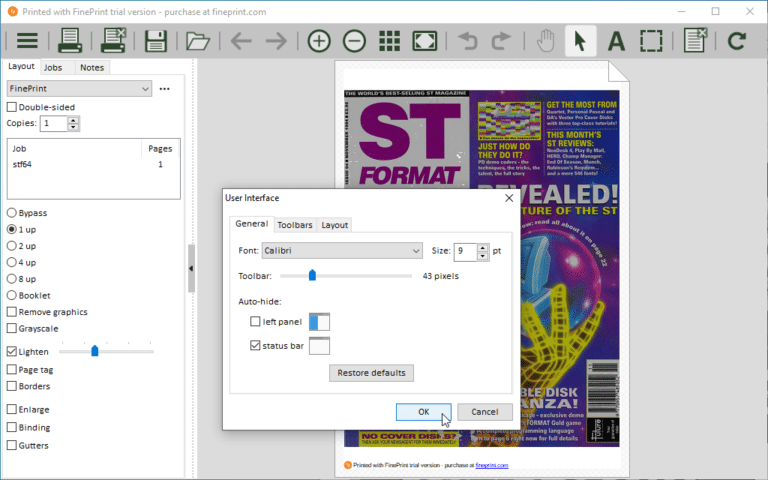

(Server Edition) right-clicking in the Users list now allows you to copy the list to the clipboard.
#DOWNLOAD FINEPRINT 6.01 FULL DRIVERS#
Please note that Windows 9x/Me and Windows NT 4.0 (kernel mode) are no longer supported, so these drivers are not installed. Printer drivers are installed for all supported Windows platforms. (Server Edition) Setup no longer presents the "Choose Platforms" dialog during installation. You can now easily hide or show the left panel with a single click on the arrow button in between the two panels The thumbnail tooltips that appear when you click and drag the scroll bar are now larger
#DOWNLOAD FINEPRINT 6.01 FULL WINDOWS 7#
The printer shortcut in the Send To folder is now created correctly under Vista and Windows 7 Nearly 1.5% of meteoroid kinetic energy is radiated out in the Ca II lines and 1 % in all other lines between 35 Å.The Add/Remove Programs entry for FinePrint now shows the version number and date of installationįixed a DLL error that happened when printing from some 32-bit applications under 64-bit Windowsįixed a bug where sometimes Setup did not create the FinePrint printer For the panchromatic luminous efficiency use of the value of −11.4 for bright Perseids is recommended. The meteor V-band luminous efficiency is found to vary in the range log τv = −11.8 to −12.0 in magnitude c.g.s. The initial masses of the two meteoroids are estimated at 40 and 80 g, respectively. Hydrogen, however, is not more abundant than in carbonaceous chondrites and thus significantly less than in cometary dust. The abundances of heavy elements are found consistent with the chemical composition of carbonaceous chondrites and the dust of comet Halley. This ratio is not an unambiguous function of meteor velocity, height and brightness but depends on the previous evolution of ablation. The ratio of both components, in terms of mass, varied smoothly from about 100:1 over 15:1 to 30:1. Two spectral components with the temperatures of 4400–4800 K and 10,000 K, respectively, are identified in the spectra in accordance with previous findings. The shift of maxima of low excitation iron lines down the trajectory in meteor flares is observed and explained by a longer radiative lifetime of the upper levels for these lines. Monochromatic light curves are constructed and the spectra are analyzed at selected points along the trajectory. Spectra of two bright ( −11 mag) Perseid meteors are studied.

a wind whoseĬhemical composition is distinctly different from the composition of its σ Ori E appears to be theįirst stellar object with a fractionated wind, i.e. Instead, arguments are brought forward that point toĪccretion caps on top of the magnetic poles, possibly of reaccreted H H-decoupling, evidently, does not play a role in The metal poor polar caps, however, cannot beĮxplained in this way. Surface enrichment of He indeed is due to decoupling of He from the The wind bases further turn out to be (practically)Ĭongruent with the observed He-patches. Wind are in good agreement with the predictions of a semi-quantitative The resulting phase variations of the photospheric Independent outer (coronal) wind which has its origin in a hot corona (photospheric) wind that feeds the corotating clouds, and a phase That there exist two wind modes: a weak and variable inner Variations of the wind are extracted from IUE-spectrograms. In order to locate the the wind bases, phase Theory of diffusion is unable toĮxplain these symmetries. The former is oriented along the magnetic dipole axis, while the He-variable HD 37479 (σ Ori E) which has two axes of symmetry, oneĬharacterized by the depletion of metals and one by the enrichment of A first example of the latter kind is shown to be the

Pronounced, if the wind is surface modulated, say by a magnetic fieldĪnd rotation. Transition regime, elemental segregation seems possible due to theĭecoupling of He and, under special circumstances, also of H from theĪbsorbing metal ions in the wind. Radiation ceases to be able to drive a stellar wind. In main-sequence stars, at effective temperatures below =~20000K,


 0 kommentar(er)
0 kommentar(er)
